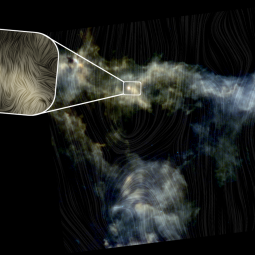By Elena Redaelli and Joan Schmelz
Paper:
Magnetic Properties of the Protostellar Core IRAS 15398-3359
E. Redaelli, et al., 2019 A&A, 631, A154.
Magnetic fields (B) are ubiquitous in interstellar space, and their role in the star-formation process is of fundamental importance. However, how they interplay with other important forces — such as gravity and turbulence — are topics currently under great debate. At the scales of dense cores (fractions of parsec), the theory of magnetically-driven collapse in a uniform field predicts first the formation of a flattened structure (a pseudodisc), since the matter can only flow along the field lines; later, the gravitational pull grows strong enough to pinch the field lines, giving rise to a characteristic hourglass shape. However, such a feature has been observed only rarely, especially in low-mass objects, for which there are only two clear detections reported in the literature.
Magnetic fields are difficult to detect, but the High-resolution Airborne Wideband Camera Plus (HAWC+) on SOFIA observes polarized dust emission at far-infrared wavelengths that are not accessible from the ground. The dust particles are predicted to align with the local magnetic field, giving rise to thermal radiation polarized perpendicularly with respect to B.
As part of its southern deployment to New Zealand in 2018, SOFIA sought to study the initial stages of low-mass star formation in a highly magnetized environment. HAWC+ targeted the low-mass protostellar core IRAS 15398-3359, which hosts a protostar younger than 104 yr. It is embedded in the Lupus I molecular cloud, the least evolved component of the Lupus complex.
Previous optical polarimetry of this cloud, which traces the low-density cloud-scale magnetic field, revealed a uniform strength of B ≈ 100 µm and a field structure aligned perpendicularly to the main axis of the cloud. We obtained new polarimetric HAWC+ data at 214 µm.
The optical and far-infrared polarization vectors both trace a common direction indicating that the core preserved the magnetic field morphology inherited by the parental cloud while it was evolving and contracting. The far-infrared data close to the central protostar reveal a uniform field that is roughly aligned with the outflow direction, as predicted by the theory of magnetically-driven collapse. However, on the south-east side of the core, the field lines pinch inward, unveiling a (partial) hourglass shape. This is not detected on the other side, possibly due to limited sensitivity. If confirmed by further, deeper observations, this would represent the first hourglass shape detected by SOFIA in the low-mass regime.
A statistical technique known as angular dispersion function analysis was used to determine the ratio of the turbulent (B t ) to uniform (B 0 ) field. The result, B t /B 0 = 0.267 ± 0.007, confirms that the uniform component dominates. We can also derive the plane-of-sky projection of the field strength, B POS = 78 µG. We also computed the gravitational-to-magnetic energy ratio, λ = 0.95. This is close to the energy balance regime (λ = 1), most likely arising from an average between the innermost part of the core, where gravity has already taken over leading to the protostar formation (λ > 1.0), and the outskirt medium, which could be still in a subcritical state (λ < 1.0).
The SOFIA results indicate that IRAS 15398-3359 evolved in a highly magnetized environment and that the ordered magnetic field was preserved from cloud scales down to core scales. For the future, we plan to analyze spectroscopic observations already collected with the Atacama Pathfinder EXperiment (APEX) in order to derive the kinematic properties of the source. These data will help us answer key questions focusing on the interaction between the magnetic field structure and the gas dynamics.

